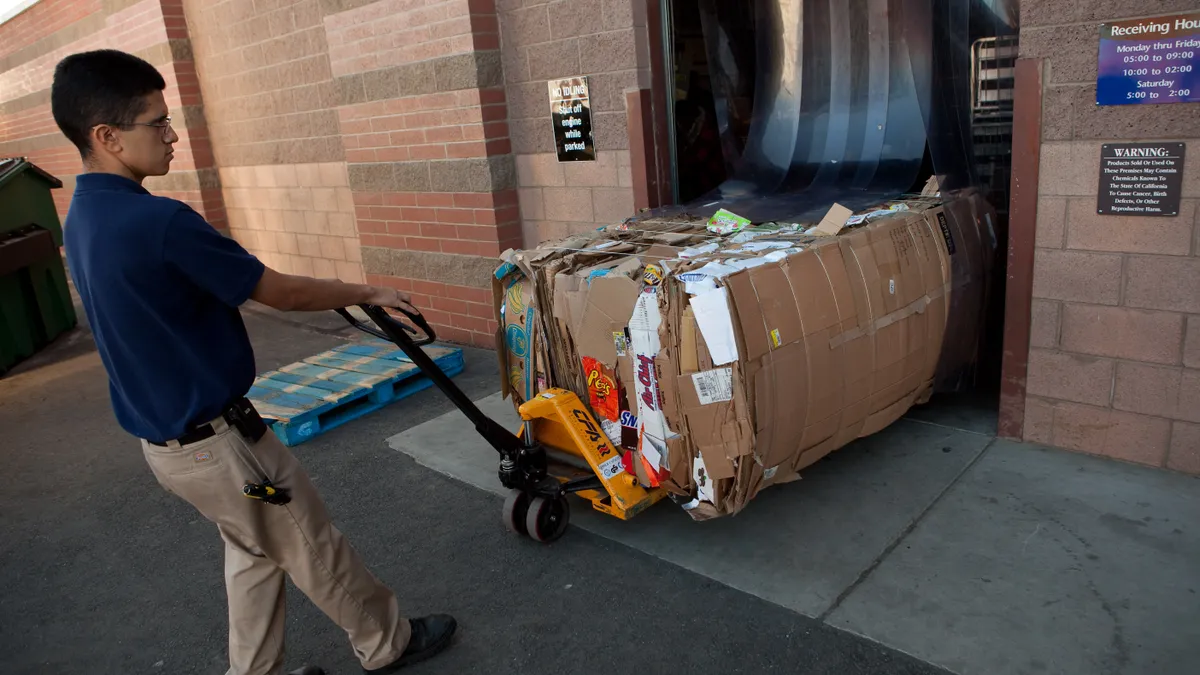Dive Brief:
- Retailers are looking for waste reduction strategies as packaging waste continues to grow, starting with decreasing the amount of non-recyclable packaging on the products they sell.
- The amount of packaging waste generated annually in the U.S. has increased by 185% between 1960 and 2015, from 27 million tons to almost 78 million tons. Recycling has become an increasingly common way to deal with this stream. Only 10% of this waste was recycled in 1960, but more than half was recycled in 2015, according to the Environmental Protection Agency. The practice of curbside recycling didn't take off until around the 1990s.
- The 10 largest U.S. retailers by revenue all either mention efforts to reduce packaging waste in annual sustainability reports or on their corporate websites, according to a review by Supply Chain Dive. Walmart wants to make the packaging for its private brand 100% recyclable by 2025, while Kroger wants to encourage customers to actually recycle the recyclable items they buy with stronger encouragement on private label packaging. Some companies also focus on the need to decrease the use of specific chemicals in packaging. Target, for example, said it is working directly with its suppliers to help eliminate chemicals that make some packaging harder to recycle.
Dive Insight:
This focus on packaging was one of the earlier sustainability efforts undertaken by many larger corporations, Alexis Bateman, the director of sustainable supply chains at MIT's Center for Transportation and Logistics, told Supply Chain Dive.
"I think of the sustainability initiatives — plastics and packaging, in particular — have been around for quite a while," Bateman said.
A survey of 358 packaging professionals conducted last year found 69% of respondents feel a high level of concern — meaning they choose seven or higher on a scale of 10 — surrounding environmental issues and plastic packaging, according to Packaging Digest and the Sustainable Packaging Coalition.
Moves to make packaging less wasteful can make consumers feel better about buying products that publicize these changes, and can also result in longer-term savings for the makers that could offset any upfront investment in a packaging switch, Bateman said.
"Rightsizing packaging so it fits the actual product more so than it used to — that's obviously a cost reduction," she said. Using more recycled material, however, can sometimes result in increased cost.
Kroger recently did just this when it redesigned the container used to transport its in-house milk brand to use 10% less plastic. "This reduction has put us well on our way to achieve our goal to reduce plastic packaging in Our Brands products we manufacture by 10 million pounds," Kroger said in its most recent sustainability report.
Some companies are going through a learning phase before making any major changes to their packaging. CVS joined the Sustainable Packaging Coalition in 2017 and is undergoing an audit of the 500 printers that produce packaging for its branded products. "We intend to use the results of this audit to help inform future standards on sustainable packaging," CVS said in its 2017 sustainability report.
Switching materials is also a potentially impactful — though sometimes difficult — option to reduce waste. Home Depot looked for alternatives to expanded polypropylene (EPS) foam when shipping products. The company doesn't say it will able to stop using it completely, but it was able to switch to molded pulp or paper for some items and was able to eliminate 341,000 cubic feet of EPS from its packaging, according to its 2018 Responsibility Report.
All this work could be good for business, since 78% of the packaging professionals believe increased recycling rates will help to "alleviate the real or perceived environmental concerns of plastic packaging," according to the Sustainable Packaging Coalition survey.
But since the goal isn't simply "perceived" benefit, it's a good thing that there is so much room for improvement. "We're using packaging at such a crazy rate in terms of last-mile delivery and online shopping, so if we can make any changes to magnitude in years to come it's going to be massive," Bateman said.














